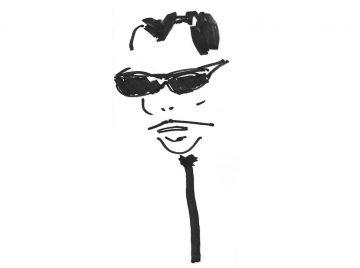Maggie Fergusson in MIL:
 LATE IN THE afternoon of June 22nd 1940, Hitler marched into a glade in the forest of Compiègne, 60km north of Paris. A giant swastika was unfurled as he saluted columns of Nazi troops, before hoisting himself into what had once been the private railway carriage of Marshal Foch. Inside this, on November 11th 1918, the Germans had signed the armistice that ended the first world war. So it was an apt spot for Hitler, sitting in Foch’s chair, and flanked by Goering, Ribbentrop and Hess, to witness the French surrender. Today, in a replica of the railway carriage, you can watch old newsreel of the Führer emerging into the evening sunshine and pulling on his leather gloves with an expression of grim satisfaction. This was a significant step towards the creation of his 1,000-year Reich. Four years later, of course, the Reich had collapsed, and Hitler was dead.
LATE IN THE afternoon of June 22nd 1940, Hitler marched into a glade in the forest of Compiègne, 60km north of Paris. A giant swastika was unfurled as he saluted columns of Nazi troops, before hoisting himself into what had once been the private railway carriage of Marshal Foch. Inside this, on November 11th 1918, the Germans had signed the armistice that ended the first world war. So it was an apt spot for Hitler, sitting in Foch’s chair, and flanked by Goering, Ribbentrop and Hess, to witness the French surrender. Today, in a replica of the railway carriage, you can watch old newsreel of the Führer emerging into the evening sunshine and pulling on his leather gloves with an expression of grim satisfaction. This was a significant step towards the creation of his 1,000-year Reich. Four years later, of course, the Reich had collapsed, and Hitler was dead.
Less than an hour’s stroll through the beech trees, a rather different piece of history is unfolding. Fifty years ago this August, a 35-year-old ex-naval officer, Jean Vanier, bought a tumbledown cottage in Trosly-Breuil, a village on the edge of the forest. The cottage had no lavatory, one tap and a wood-burning stove, and he called it L’Arche—The Ark. He then invited two men with mental disabilities, Raphaël Simi and Philippe Seux, to leave the bleak, overcrowded asylum where they had spent most of their adult lives, and to make a home with him. “There was”, he says, looking back, “no huge idea of doing something special that might change the world.”
He thought that he, Raphaël and Philippe might remain one small family, able to fit comfortably into his battered car for outings. But, like the biblical mustard seed, L’Arche grew beyond all expectations. Friends came to visit, and were inspired by Jean Vanier’s insistence that those with mental disabilities have gifts that many “normal” people lack. More houses were bought, more men and women rescued from institutions. Today, there are L’Arche communities in every continent of the world—146 of them, in 35 countries, from Bangladesh to Burkina Faso, Ireland to the Ivory Coast, Palestine to the Philippines.
More here.
 Sometimes, it is the very ordinariness of a scene that makes it terrifying. So it was with a clip from last week’s BBC documentary on facial recognition technology. It shows the Metropolitan police trialling a facial recognition system on an east London street
Sometimes, it is the very ordinariness of a scene that makes it terrifying. So it was with a clip from last week’s BBC documentary on facial recognition technology. It shows the Metropolitan police trialling a facial recognition system on an east London street
 LATE IN THE
LATE IN THE  Plastic makes up nearly 70% of all ocean litter
Plastic makes up nearly 70% of all ocean litter It’s amazing that this landmark symphony could have been so easily forgotten. As with the other seminal New Englanders—George Whitefield Chadwick, Horatio Parker, and Edward MacDowell, among them—modernism killed off Paine’s music. And with the ascendancy of American vernacular forms, reflected in the music of Charles Ives, Aaron Copland, and others, any music arising from the German Romantic tradition could be ridiculed and ignored. Paine may have been the acknowledged dean of a New England school, but he could not be comfortably located with any American school. Even Paine’s student Richard Aldrich, writing in the early 20th century, argued that Paine’s music, despite its “fertility,” “genuine warmth,” “spontaneity of invention,” and “fine harmonic feeling,” did not “disclose ‘American’ characteristics.” But what in Paine’s time and cultural milieu would have constituted an American characteristic?
It’s amazing that this landmark symphony could have been so easily forgotten. As with the other seminal New Englanders—George Whitefield Chadwick, Horatio Parker, and Edward MacDowell, among them—modernism killed off Paine’s music. And with the ascendancy of American vernacular forms, reflected in the music of Charles Ives, Aaron Copland, and others, any music arising from the German Romantic tradition could be ridiculed and ignored. Paine may have been the acknowledged dean of a New England school, but he could not be comfortably located with any American school. Even Paine’s student Richard Aldrich, writing in the early 20th century, argued that Paine’s music, despite its “fertility,” “genuine warmth,” “spontaneity of invention,” and “fine harmonic feeling,” did not “disclose ‘American’ characteristics.” But what in Paine’s time and cultural milieu would have constituted an American characteristic? Somehow I became respectable. I don’t know how—the last film I directed got some terrible reviews and was rated NC-17. Six people in my personal phone book have been sentenced to life in prison. I did an art piece called Twelve Assholes and a Dirty Foot, which is composed of close-ups from porn films, yet a museum now has it in their permanent collection and nobody got mad. What the hell has happened?
Somehow I became respectable. I don’t know how—the last film I directed got some terrible reviews and was rated NC-17. Six people in my personal phone book have been sentenced to life in prison. I did an art piece called Twelve Assholes and a Dirty Foot, which is composed of close-ups from porn films, yet a museum now has it in their permanent collection and nobody got mad. What the hell has happened? There is a lot of horror in this book. People are thrown from helicopters into the sea, their arms tied behind their backs. A colonel grinds up his victims’ bodies and feeds them to his dogs. Forché finds mutilated corpses by the side of the road. She visits a prison where men are kept in cages the size of washing machines. She and a friend are pursued by an escuadrón de la muerte (death squad). Later, she meets a man who was a member of one such squad, who recalls the sound of bubbles as he cut his victims’ throats.
There is a lot of horror in this book. People are thrown from helicopters into the sea, their arms tied behind their backs. A colonel grinds up his victims’ bodies and feeds them to his dogs. Forché finds mutilated corpses by the side of the road. She visits a prison where men are kept in cages the size of washing machines. She and a friend are pursued by an escuadrón de la muerte (death squad). Later, she meets a man who was a member of one such squad, who recalls the sound of bubbles as he cut his victims’ throats. Why do we like what we like? The books, movies, photos, and artworks that form our perspective—who puts them in front of us? One answer is the critic, that cipher of taste who places art in its various corridors, then augments, defines, degrades, and ultimately shapes the works that shape us. In times when the public’s eye travels with ever more scope but not necessarily more depth, criticism, the act of choosing—and so much more—becomes more important than ever. It’s for this reason that so many eyes are turning to Parul Sehgal and Teju Cole, two critics—as well as editors, essayists, and artists—challenging not only us but art forms themselves.
Why do we like what we like? The books, movies, photos, and artworks that form our perspective—who puts them in front of us? One answer is the critic, that cipher of taste who places art in its various corridors, then augments, defines, degrades, and ultimately shapes the works that shape us. In times when the public’s eye travels with ever more scope but not necessarily more depth, criticism, the act of choosing—and so much more—becomes more important than ever. It’s for this reason that so many eyes are turning to Parul Sehgal and Teju Cole, two critics—as well as editors, essayists, and artists—challenging not only us but art forms themselves. Most people in the modern world — and the vast majority of Mindscape listeners, I would imagine — agree that humans are part of the animal kingdom, and that all living animals evolved from a common ancestor. Nevertheless, there are ways in which we are unique; humans are the only animals that stress out over Game of Thrones (as far as I know). I talk with geneticist and science writer Adam Rutherford about what makes us human, and how we got that way, both biologically and culturally. One big takeaway lesson is that it’s harder to find firm distinctions than you might think; animals use language and tools and fire, and have way more inventive sex lives than we do.
Most people in the modern world — and the vast majority of Mindscape listeners, I would imagine — agree that humans are part of the animal kingdom, and that all living animals evolved from a common ancestor. Nevertheless, there are ways in which we are unique; humans are the only animals that stress out over Game of Thrones (as far as I know). I talk with geneticist and science writer Adam Rutherford about what makes us human, and how we got that way, both biologically and culturally. One big takeaway lesson is that it’s harder to find firm distinctions than you might think; animals use language and tools and fire, and have way more inventive sex lives than we do. Earlier this year, the presidents of Sudan and Algeria both announced they would step aside
Earlier this year, the presidents of Sudan and Algeria both announced they would step aside  A
A  Scientists have created a living organism whose DNA is entirely human-made — perhaps a new form of life, experts said, and a milestone in the field of synthetic biology. Researchers at the Medical Research Council Laboratory of Molecular Biology in Britain reported on Wednesday that they had rewritten the DNA of the bacteria Escherichia coli, fashioning a synthetic genome four times larger and far more complex than any previously created. The bacteria are alive, though unusually shaped and reproducing slowly. But their cells operate according to a new set of biological rules, producing familiar proteins with a reconstructed genetic code. The achievement one day may lead to organisms that produce novel medicines or other valuable molecules, as living factories. These synthetic bacteria also may offer clues as to how the genetic code arose in the early history of life.
Scientists have created a living organism whose DNA is entirely human-made — perhaps a new form of life, experts said, and a milestone in the field of synthetic biology. Researchers at the Medical Research Council Laboratory of Molecular Biology in Britain reported on Wednesday that they had rewritten the DNA of the bacteria Escherichia coli, fashioning a synthetic genome four times larger and far more complex than any previously created. The bacteria are alive, though unusually shaped and reproducing slowly. But their cells operate according to a new set of biological rules, producing familiar proteins with a reconstructed genetic code. The achievement one day may lead to organisms that produce novel medicines or other valuable molecules, as living factories. These synthetic bacteria also may offer clues as to how the genetic code arose in the early history of life.


 Madeleine LaRue: It did turn out to be pretty mammoth! How about I tell you, by way of introduction, about the first time I met Bichsel in person. He’d come to read at the Literarisches Colloquium in Berlin, the center of the grand old West Berlin literary establishment. It was November, it was dark and cold, and when he emerged at the back of the room and started walking up toward the stage, wearing the same black leather vest he’s been wearing for the past forty years, I think we were all a little worried about him. He was eighty-two then, and he looked exhausted. It had been a while since he’d been on such an extensive reading tour outside of Switzerland. He got to the stage and settled into his chair. The moderator welcomed him and asked how it felt to be back in Berlin—a simple question, a nice, easy opener. Bichsel still seemed tired, but as he leaned back and said, very slowly, in his lilting Swiss accent, “Ja, ja, Berlin,” his eyes lit up and he launched into a story about his first time in the city, in the early 1960s, and how he got caught in the middle of a bar fight with some people! Who turned out to be Swiss! And they all got thrown out onto the street together, and he’ll never forget it! And ja, ja, Berlin—and from his very first word, we all became like delighted children at Grandfather’s feet, totally enraptured, utterly unwilling to go to bed until we’d heard just one more story, pleeeease? And he himself became younger, full of life, charming and hilarious and genuine and profound.
Madeleine LaRue: It did turn out to be pretty mammoth! How about I tell you, by way of introduction, about the first time I met Bichsel in person. He’d come to read at the Literarisches Colloquium in Berlin, the center of the grand old West Berlin literary establishment. It was November, it was dark and cold, and when he emerged at the back of the room and started walking up toward the stage, wearing the same black leather vest he’s been wearing for the past forty years, I think we were all a little worried about him. He was eighty-two then, and he looked exhausted. It had been a while since he’d been on such an extensive reading tour outside of Switzerland. He got to the stage and settled into his chair. The moderator welcomed him and asked how it felt to be back in Berlin—a simple question, a nice, easy opener. Bichsel still seemed tired, but as he leaned back and said, very slowly, in his lilting Swiss accent, “Ja, ja, Berlin,” his eyes lit up and he launched into a story about his first time in the city, in the early 1960s, and how he got caught in the middle of a bar fight with some people! Who turned out to be Swiss! And they all got thrown out onto the street together, and he’ll never forget it! And ja, ja, Berlin—and from his very first word, we all became like delighted children at Grandfather’s feet, totally enraptured, utterly unwilling to go to bed until we’d heard just one more story, pleeeease? And he himself became younger, full of life, charming and hilarious and genuine and profound.